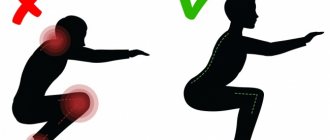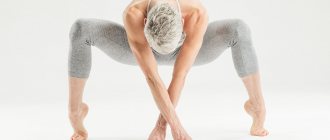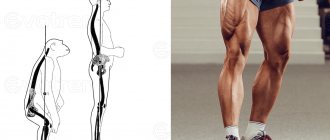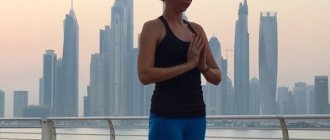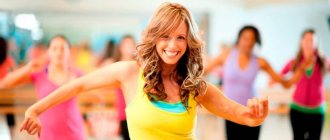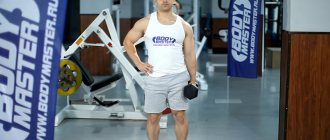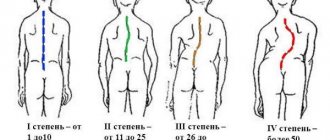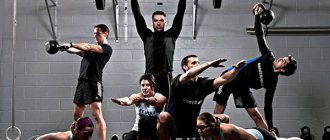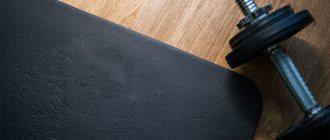March 16, 2011
Are you flexible enough? Determine this with nine simple tests.
In order for the body to move easily and effectively, pumped up muscles are not enough. Flexible joints allow a person to perform almost any movement smoothly and without injury. Marina Makarova, head of the exercise therapy department at the Center for Restorative Medicine and Rehabilitation of the Treatment and Rehabilitation Center of the Russian Ministry of Health and Social Development, talks about how to check how flexible your joints are.
Test No. 9
Stand in front of the mirror sideways without bending your knees.
Follow the line of your legs in the area of your knees. If your knee is slightly bent backward (as the kids say, “knees back”), the joint is hypermobile. If it is bent forward, its flexibility is insufficient. If the line of the leg is absolutely straight, everything is normal. Tags:
- Home workouts
- Back
- Flexibility
- Diagnostics
- Joints
- Testing
To leave a comment you must be an authorized user
Checking the flexibility of the body
The main indicator of the strength and youth of our body is its flexibility. Young children are always very flexible and active, but, unfortunately, with age we lose this wonderful skill. Over time, the joints become less mobile, and back pain is very common. Don't want to put up with this reality? Then start developing your body flexibility right now. But first you need to assess your level of plasticity; to do this, just do a few simple tests.
Spine.
First, check the flexibility of the spine. The test we propose will allow you to determine how completely mobile the joints of the spinal column are. Stand up straight, lean forward and try to touch the floor with your legs straight. If you succeed, then the flexibility of your spine can be considered normal. You need to develop your spinal joints so that you can place your palms on the floor.
The second test to determine the flexibility of the spine is as follows: stand against a wall and make a pencil mark at shoulder level. Now move 1-2 steps away from the wall, raise your left hand and try to reach the mark that you put on the wall.
Lateral flexibility.
It is necessary to tilt to the sides, while your hands should slide along your thigh. When performing this exercise, you should not lean forward or backward and should not turn your torso. If you were able to do a side bend and reach the middle of the knee joint with your fingers, then you have good lateral flexibility.
Shoulder joints.
To determine the flexibility of your shoulder joints, you need to stand straight and spread your legs slightly. Take any small object in your left hand and raise your arm up, bending it behind your head. At the same time, lower your other arm down and bend it behind your back. If you were able to effortlessly pass an object from one hand to the other, then you have good flexibility in your shoulder joints.
Testing hip flexibility
Indicators of hip flexibility are especially important for women after 30 years of age. However, it wouldn’t hurt to get men checked, too, because in both sexes the risk of fractures and sprains increases with age.
Sit on the floor with your legs slightly apart. Bend your right leg, tucking it under you, and straighten your left leg. After this, begin to lean towards the outstretched leg, clasping it with your hand. The ideal option would be a distance between the face and the floor of at least 30 cm.
Evaluation criteria:
- “A” – Exercise completed. If you have completed the exercise and are able to touch your knee to your forehead, remain in this position for at least a few seconds.
- “B” – Exercise not completed. If you were unable to fully straighten your leg, this means that your joints are immobile and your back muscles are not elastic enough.
Sports and flexibility
High demands on the flexibility of athletes are made in complexly coordinated sports disciplines.
These include:
- acrobatics;
- gymnastics;
- synchronized swimming;
- diving;
- slalom;
- freestyle;
- figure skating.
Dexterity is in demand in martial arts, various types of wrestling, and team sports. In physical education, it is important when doing fitness and yoga. This quality of the body allows you to achieve good results, improve your health and form an impeccable figure. Without proper agility, it is impossible to succeed in football, basketball, and handball. Such disciplines provide for constant improvement of the functions of the motor analyzer and improvement of the coordination capabilities of the body.
Muscle-joint structures are strengthened, skin sensations and posture are improved. Flexibility in sports is necessary to improve orienting reactions, the ability to maintain balance during complex and rapid movements in space, especially in conditions of limited or absent support. Acrobatic and gymnastic exercises stimulate the musculoskeletal system. The training effect is to increase joint and ligament elasticity.
Flexibility in physical education.
These physical characteristics allow you to perform sports movements with greater amplitude. Each sport has different types of flexibility. In rhythmic gymnastics, high demands are placed on the spatio-temporal differentiation of strength indicators when performing techniques with paraphernalia under conditions of limited visual control. Ski jumping requires the athlete to have good functionality of the vestibular analyzer.
With relatively low energy costs, this sport is characterized by high emotional stress, which, if preparedness is insufficient, can lead to a decrease in overall performance.
Shoulder rotators
Sit on a chair with your side facing the mirror. Spread your arms to the sides and bend your elbows 90 degrees. Without changing the angle of bend in your elbows, turn your arms up and back, trying to move your palms as far behind your head as possible.
Now turn your arms as far as possible in the other direction, lowering them down.
- Good: the palms are level with the level of the head at the top point and the center line of the body at the bottom. Moreover, both extreme positions are symmetrical relative to each other.
- Excellent: the palms have passed a vertical line running along the body and head at both points. Moreover, both extreme positions are symmetrical relative to each other.
- Cool: the end positions of the forearms at both points are perpendicular to each other and symmetrical.
Exercises for different levels
For those just starting to practice body flexibility, the statistical stretching method is recommended. Its essence lies in the fact that a person stretches as far as he can, and then holds the stretching position for some time. When doing this stretch, you should be relaxed and not perform any range of motion.
There are two types of static stretching:
- active - the stretched position is maintained solely by the force of the muscles (for example, a raised leg is held in this position by the force of its own muscles);
- passive - the stretched position of the body is maintained by its own weight or certain parts of the body, as well as with the help of some objects or a partner.
Dynamic stretching is suitable for those with an average level of flexibility. Its essence is to gradually increase the amplitude of muscle movement without going beyond the natural range of motor activity. Usually these are controlled swings of the arms and legs, bends and turns of the body. With this stretching, jerking and other sudden movements are not used.
Exercises at home and in the studio: pros and cons
Stretching at home
The undeniable advantage in this case, of course, is saving money and time. You don't need to buy a subscription or pay for individual lessons with a trainer, or waste time getting to the fitness studio. Suitable stretching routines can be found on the Internet and practiced at home.
However, there are also disadvantages: the wrong choice of exercises and their execution will not lead to the desired result. In addition, the risk of injury is high.
Stretching in the studio
An experienced trainer will select exercises that suit you and check that they are performed correctly. If you buy a subscription for a certain number of classes, at the initial stage it will become an incentive not to quit what you started, since training at home requires good self-discipline.
As for the downsides, as we said, classes in the studio require a certain investment of money and time to get to the training place. Therefore, choose a fitness studio near your home or work, and also pay attention to the cost of services.
Checking the flexibility of the shoulder joint
Mobility of the shoulder joints is not only the key to beautiful posture, but also to the proper functioning of the respiratory system. That is why the results of this test should be taken seriously.
Starting position – sitting on your heels with a straight back. From this position, you need to bring your hands behind your back and place them behind your back in a prayer position. When performing the exercise ideally, your arms should be bent at the elbows.
Evaluation criteria:
- “A” – the exercise was performed very easily. If you quickly and easily completed this exercise without feeling pain in the muscles and joints, this means that your flexibility is at a very high level and problems with the shoulder joint are not expected.
- “B” – the exercise is completed, but with difficulties. Painful sensations indicate that you need to practice more and spend time stretching.
- “C” – the exercise was not completed, it turned out to be too difficult. If you were unable to bring your hands together, then carefully hold your elbows with your palms behind your back, remaining in this position for several minutes. Perform this exercise daily, otherwise there is a high risk of developing frozen shoulder syndrome, when there is a gradual restriction of the mobility of the shoulder joint against the background of prolonged pain.
The best exercises for flexibility
Hatha yoga is one of the oldest, if not the oldest, practice for working with the flexibility of the physical body, it is at least several thousand years old, perhaps much more. Accordingly, it is worth studying the yoga approach to working with the body.
Many yoga asanas are aimed specifically at developing flexibility; asanas in hatha yoga, according to ancient yogic treatises, range from several thousand to several million. A few dozen are enough to work the whole body, develop flexibility, strengthen muscles, including deep ones, which cannot be strengthened in any other way.
Flexibility exercises are:
- Paschimottanasana;
- Adho Mukha Svanasana;
- Urdhva Mukhva Svanasana;
- Bhujangasana;
- Bhuja Svastikasana;
- Eka Bhuja Svastikasana 2;
- Baddhakonasana;
- Virasana;
- Ardha Padmasana;
- Padmasana;
- Ushtrasana;
- Uttanasana.
But in order to develop flexibility comprehensively, practice comprehensively, that is, do not limit yourself to any one set of asanas, but add new ones periodically.
What does flexibility depend on?
The stretching capacity of the body is limited by muscle fibers and their elasticity. Flexibility depends on several influencing factors. It is limited by antagonistic muscles and their tense state. When performing stretching exercises, the muscles are relaxed as much as possible to reduce resistance. Flexibility in physical education is a variable quantity. The sports indicator is influenced by constant factors and training conditions. In the period from 12:00 to 17:00, the mobility of joints, ligaments and tendons is higher than at other times of the day.
Air temperature matters. The colder it is, the less flexible it is. It is significantly increased by warming up. Flexibility depends on body temperature. After warming up in a sauna, bathhouse or solarium, joint mobility increases. The tensile capacity is influenced by the current functional state of the body. When tired, flexibility decreases. This occurs due to the difficulty of complete relaxation of muscle structures and a decrease in the tone of biological tissues that resist stretching.
Influencing factors include gender, heredity and features of the anatomical structure of the body. Girls' initial data for developing flexibility are better than men's. It is easier for women to achieve rapid progress when increasing joint mobility.
Test Taking Tips for Beginners
- Do the exercises below regularly; beginners should do them at least three times a week. Gradually it is necessary to increase the load and the number of approaches.
- Before training, do not forget to do a warm-up, which will warm up your body and prepare it for the load. Push-ups, jumping rope, and running are suitable for this purpose.
Test Taking Tips for Beginners
- There is no need to try to master complex exercises from the first lessons; rash actions only lead to injuries; stretching is a gradual process that requires willpower and patience.
- Each exercise is performed 8 times, over time you can increase the load or move on to more complex movements.
- Avoid sudden and fast movements; they are unacceptable in exercises to develop flexibility.
Sources[edit | edit code]
- ↑ 1,01,11,21,31,41,51,61,7 Godik, M.A. Sports metrology. Textbook for physical institutes. cult / M.A. One year old. - M.: Physical culture and sport, 1988. - 192 p., ill.
- Gorsky, L. Training of hockey players: Trans. from Slovak / Preface G. Mkrtichana. - M.: Physical culture and sport, 1981 - 224 p., ill.
- ↑ 3.03.13.2 Zankovets, V.E. If you want to finish hockey, kill your body / V.E. Zankovets. — Minsk: A.N. Varaksin, 2014. - 160 p.
- ↑ 4,04,14,24,3 Zatsiorsky, V.M. Physical qualities of an athlete (basics of theory and methods of education) / V.M. Zatsiorsky. — 2nd ed. - M.: Publishing House "Physical Culture and Sports", 1970. - 199 p.
- ↑ 5,005,015,025,035,045,055,065,075,085,095,105,115,125,13 Nikonov, Yu.V. Physical training of hockey players: methodological manual / Yu.V. Nikonov. - Minsk: Witposter, 2014. - 576 p.
- ↑ 6,06,16,26,36,46,5 Savin, V.P. Theory and methodology of hockey: A textbook for students. higher schools, institutions / V.P. Savin. - M.: Publishing House, 2003. - 400 p.
- ↑ 7,07,17,27,3 Solodkov, A.S. Physiology of sports: Textbook / A.S. Solodkov, E.B. Sologub. — SPbGAFK im. P. F. Lesgaft. St. Petersburg, 1999. -231 p.
- ↑ 8,008,018,028,038,048,058,068,078,088,098,108,118,128,138,148,158,168,178,188,198,208,218,22 Kholodov, Zh.K. Theory and methodology of physical education and sports: Textbook, manual for students. higher schools, institutions / Zh.K. Kholodov, V.S. Kuznetsov. — 2nd ed., rev. and additional - M.: Publishing House, 2003. - 480 p.
- Baumgartner, T. Measurement for Evaluation in Physical Education and Exercise Science / T. Baumgartner, A. Jackson. — Dubuque, IA: Brown, 1987.
- ↑ 10,010,110,210,3 Essentials of strength training and conditioning. National Strength and Conditioning Association / Editors TR Baechle, RW Earle. — 3rd ed. - Hong Kong: Human Kinetics, 2008. - 642 p.
- ↑ 11,011,111,211,311,4 Matveev, L.P. Theory and methodology of physical education (general foundations of the theory and methodology of physical education; theoretical and methodological aspects of sports and professionally applied forms of physical education): Textbook, for the Institute of Physics. culture / L.P. Matveev. - M.: Physical culture and sport, 1991. - 543 p., ill.
- Zankovets, V.E. Periodization of testing in team sports / V.E. Zankovets, V.P. Popov // Science and modernity: collection of articles of the International Scientific and Practical Conference (June 5, 2015, Ufa), in 2 parts 4.1 / - Ufa: Aeterna. - 2015. - pp. 147-149.
- ↑ 13,013,113,213,313,413,513,613,7 Godik, M.A. Complex control in sports games / M.A. Godik, A. P. Skorodumova. - M.: Soviet Sport, 2010. - 336 p.: ill.
- ↑ 14,014,114,214,314,414,514,6 Fry, A. Measurement and Evaluation / A. Fry // Presentation 5: Essentials of Strength Training and Conditioning Multimedia Symposium / NSCA Certification Commission. - Lincoln, 2006. - 36 p.
- ↑ 15,015,115.2 Fitness testing / Topend Sports: the Sport & Science Resource. — Mode of access: https://www.topendsports.com/testing/index.htm. — Date of access: 12/24/2015.
- High-performance sports conditioning / Editor B. Foran. — Human Kinetics, 2001. — 376 p.
- ↑ 17,017,1 Central Scouting, - Mode of access: https://www.centralscouting.nhl. com. — Date of access: 07/14/2015.
- ↑ 18,018,1 Gledhill, N. Detailed assessment protocols for NHL entry draft players / N. Gledhill, V. Jamnik // Toronto: York University, 2007. - 28 p.
- Adams, GM Exercise Physiology Lab Manual. — 3rd ed. - Dubuque, IA: McGraw-Hill, 1998.
- American Alliance for Health, Physical Education, Recreation and Dance. AAHPERD Health-Related Fitness Test. Reston. —VA, 1980.
- American College of Sports Medicine. ACSM's Guidelines for Exercise Testing and Prescription / Franklin, BA, MH Whaley, ET Howley, GJ Balady // Philadelphia: Lippincott, Williams & Wilkins. — 7th ed. — 2006.
- Gould, D. Goal setting for peak performance. In: Applied Sport Psychology / D. Gould. — 2nd ed. — J. E. Williams, ed. Mountain View, CA: Mayfield. - 1993. - P. 158-169.
- Kordich, J. Evaluating your client: Fitness assessment protocols and norms / J. Kordich // NSCA Certification Commission Essentials of Personal Training Symposium Workbook Presentation 4, 18-19. - Lincoln, NE: NSCA Certification Commission, 2006.
- Nieman, DC Fitness and Sports Medicine / DC Nieman. — 3rd ed. - Palo Alto, CA: Bull, 1995.
- Stone, M. Weight Training: A Scientific Approach / M. Stone, N. O'Bryant. - Minneapolis: Burgess, 1987.
- Anderson, B. Flexibility testing / B. Anderson // NSCA J. - 1981. - No. 3 (2). — P. 20-23.
Method No. 1. Doorjamb test
To test the flexibility of your hips, stand near a door frame or other tall, narrow object with one foot in the opening and the other near the wall. Get down on the knee of the leg that is next to the wall and lean your spine on the door frame. In this case, the spine should be in a vertical position. There will still be a small free gap between the back and the jamb, which is what we will try to remove. To do this, you just need to tilt the lower part of the pelvis so that this gap disappears. That is, it’s as if you are spreading your back along the doorframe. If you feel tightness in your hip flexors while doing this exercise, it means they are too stiff.
Now a little about anatomy so that we understand what exactly we are pulling.
The hip flexor muscles include the quadriceps muscle and the sartorius muscle.
The sartorius muscle (lat. musculus sartorius) is a muscle of the anterior thigh. It is the longest muscle in the human body. Its functions: bends the leg at the hip and knee joints, rotates the lower leg inward, and the thigh outward. Thus, he takes part in throwing his legs behind his legs.
The quadriceps femoris muscle (lat. Musculus quadriceps femoris) - occupies the entire front and partly the lateral surface of the thigh. Consists of four heads: the rectus femoris, vastus medialis, vastus lateralis, and vastus intermedius (the weakest). Its functions: extends the lower leg at the knee joint. The rectus femoris muscle, which spans the hip joint, is involved in hip flexion.
Wikipedia
ffactor.ru
Leg Bend Exercise
Sitting on the floor, spread your straight legs as wide as your stretch allows. Bend towards your right leg first, keeping your back straight and without bending your knee.
Bend as low as possible, but don’t push yourself through force and pain. Repeat the same for the other leg. Your goal is to rest your torso completely on your leg. Breathe slowly and deeply. After this, tilt your torso between your legs, the sequence of actions does not change: you need to place your torso on the floor. Return to the starting position.

